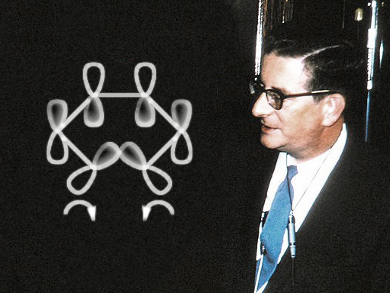In 1965, Robert Burns Woodward and Roald Hoffmann proposed a theory to explain the stereospecificity of pericyclic reactions. In several publications over the course of the year, they developed their selection criteria for symmetry-allowed reactions, now known as the Woodward-Hoffmann rules.
The rules predict the barrier height for ring closing reactions based on the symmetry of the highest occupied molecular orbital (HOMO). If the barrier is low the reaction is considered to be “symmetry-allowed”, if the barrier is high, as “symmetry-forbidden”. The first example of successful predictions were ring-closing reactions of conjugated polyenes. Since the symmetry of the orbital in question depends only on two factors, Woodward and Hoffmann could give a simple explanation of the stereoselectivity. The two deciding properties are the number of π electrons in the conjugated system, and whether the reaction is induced using heat or light. Thermal reactions start from the molecule’s ground state, while in photochemical reactions, one electron is promoted to a higher orbital with a different symmetry.
Depending on these two values, the ring-closing proceeds either in a “conrotatory” or in a “disrotatory” fashion. In a conrotatory reaction, the p orbitals at the end of the conjugated chain are rotated in the same direction and the substitutents end up in a trans conformation, vice versa for disrotatory reactions. The rules can be summarized neatly:
|
||||||||||||||||||
|
||||||||||||||||||
These easy-to-use and broadly applicable rules are basic organic chemistry knowledge today. Based on this achievement, Roald Hoffmann received the Nobel Prize in Chemistry in 1981 together with Kenichi Fukui “for their theories, developed independently, concerning the course of chemical reactions”. Woodward, who had already been awarded an unshared Nobel Prize for his work in organic synthesis (1965), had died in 1979, and could not be honored posthumously.
Even though the rules are so closely linked to the names of their discoverers today, there has been some controversy over the origin of the idea. In a 2004 article, Fellow Nobel Laureate E. J. Corey claimed that he had suggested the idea of the importance of orbital symmetry to Robert Woodward as early as 1964. The rebuttal by Roald Hoffmann, also published in 2004, rejects this late claim for credit, and posits that Corey’s suggestion was not a significant factor in the discovery.
Robert Burns Woodward, born in Boston, MA, USA, on April 10, 1917, studied chemistry at the Massachusetts Institute of Technology (MIT), Cambridge, MA, USA, where he received his Ph.D. in 1937. After a postdoctoral stay at the University of Illinois, Champaign, IL, USA, he joined Harvard University, Cambridge, MA, USA, in 1937, and remained there in various capacities until his retirement. Professor Woodward died on July 8, 1979.
Professor Woodward held more than twenty honorary degrees, and was awarded numerous prizes, including the National Medal of Science by the United States of America in 1964 and the Lavoisier Medal by the Societé Chimique de France (French Chemical Society, SCF) in 1968. His research focused on the synthesis of complex natural products, and he won the Nobel Prize in Chemistry in 1965 “for his outstanding achievements in the art of organic synthesis”.
Roald Hoffmann, born in Zolochiv in today’s Ukraine on July 18, 1937, emigrated with his family to the United States in 1949. He studied chemistry at Columbia University, New York, USA, received his Master’s degree from Harvard University, Cambridge, MA, USA in 1960, and gained his Ph.D. there in 1962. In 1965, Hoffmann joined Cornell University, Ithaca, NY, USA, as Associate Professor of Chemistry. In 1968, he was appointed Professor of Chemistry, and became John A. Newman Professor of Physical Science in 1974. he is Professor Emeritus at Cornell.
Professor Hoffmann’s research focuses on applied theoretical chemistry. Hoffmann is also a poet and playwright, often incorporating science into his fictional works. Among many other honors, including over twenty-five honorary degrees, he has received the Nobel Prize in Chemistry in 1981 together with Kenichi Fukui “for their theories, developed independently, concerning the course of chemical reactions”.
Robert Burns Woodward is the answer to Guess the Chemist (46).
Selected Publications
- A Claim on the Development of the Frontier Orbital Explanation of Electrocyclic Reactions,
Roald Hoffmann,
Angew. Chem. Int. Ed. 2004, 43, 6586–6590.
DOI: 10.1002/anie.200461440 - Impossible Dreams,
E. J. Corey,
J. Org. Chem. 2004, 69, 2917–2919.
DOI: 10.1021/jo049925d - Stereochemistry of Electrocyclic Reactions,
R. B. Woodward, Roald Hoffmann,
J. Am. Chem. Soc. 1965, 87, 395–397.
DOI: 10.1021/ja01080a054 - Selection Rules for Concerted Cycloaddition Reactions,
Roald Hoffmann, R. B. Woodward,
J. Am. Chem. Soc. 1965, 87, 2046–2048.
DOI: 10.1021/ja01087a034 - Orbital Symmetries and endo-exo Relationships in Concerted Cycloaddition Reactions,
Roald Hoffmann, R. B. Woodward,
J. Am. Chem. Soc. 1965, 87, 4388–4389.
DOI: 10.1021/ja00947a033 - Selection Rules for Sigmatropic Reactions,
R. B. Woodward, Roald Hoffmann,
J. Am. Chem. Soc. 1965, 87, 2511–2513.
DOI: 10.1021/ja01089a050 - Orbital Symmetries and Orientational Effects in a Sigmatropic Reaction,
Roald Hoffmann, R. B. Woodward,
J. Am. Chem. Soc. 1965, 87, 4389–4390.
DOI: 10.1021/ja00947a034
Also of Interest
- Strychnine: From Isolation to Total Synthesis – Part 2,
Klaus Roth,
ChemViews Mag. 2015.
Why did it take 130 years to determine the structure of strychnine? - A Chemical Examination of the Isenheim Altar: Role Played in History by Horned Rye (3),
Klaus Roth and Sabine Streller,
ChemViews Mag. 2013.
The isolation and structural determination of the potent ergot alkaloids guarantees we can enjoy our daily bread without harm - The Chemist’s Fear of the Fugu,
Klaus Roth,
ChemViews Mag. 2011.
The chemist’s fear of the fugu or pufferfish extends as far as the distinctive and intriguing poison it carries




